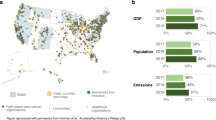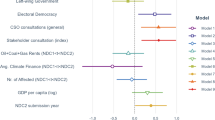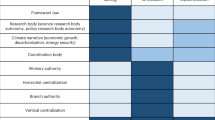Abstract
Non-state and subnational climate actors have become central to global climate change governance. Quantitatively assessing climate mitigation undertaken by these entities is critical to understand the credibility of this trend. In this Perspective, we make recommendations regarding five main areas of research and methodological development related to evaluating non-state and subnational climate actions: defining clear boundaries and terminology; use of common methodologies to aggregate and assess non-state and subnational contributions; systematically dealing with issues of overlap; estimating the likelihood of implementation; and addressing data gaps.
This is a preview of subscription content, access via your institution
Access options
Access Nature and 54 other Nature Portfolio journals
Get Nature+, our best-value online-access subscription
$29.99 / 30 days
cancel any time
Subscribe to this journal
Receive 12 print issues and online access
$209.00 per year
only $17.42 per issue
Buy this article
- Purchase on Springer Link
- Instant access to full article PDF
Prices may be subject to local taxes which are calculated during checkout


Similar content being viewed by others
Data availability
The data and R script to produce Fig. 2 are available upon request from the authors of this study.
References
Rockström, J. et al. A roadmap for rapid decarbonization. Science 355, 1269–1271 (2017).
Rogelj, J. et al. Paris Agreement climate proposals need a boost to keep warming well below 2 °C. Nature 534, 631–639 (2016).
Rogelj, J. et al. Scenarios towards limiting global mean temperature increase below 1.5 °C. Nat. Clim. Change 8, 325–332 (2018).
Blok, K., Höhne, N., der Leun, K. & Harrison, N. Bridging the greenhouse-gas emissions gap. Nat. Clim. Change 2, 471–474 (2012).
Hsu, A., Moffat, A. S., Weinfurter, A. J. & Schwartz, J. D. Towards a new climate diplomacy. Nat. Clim. Change 5, 501–503 (2015).
Climate Commitments of Subnational Actors and Business: A Quantitative Assessment of Their Emission Reduction Impact (UNEP, 2015).
Graichen, J. et al. International Climate Initiatives – A Way Forward to Close the Emissions Gap? Initiatives’ Potential and Role Under the Paris Agreement (Environmental Research of the Federal Ministry for the Environment, Nature Conservation, Building and Nuclear Safety, 2017).
Roelfsema, M., Harmsen, M., Olivier, J. J., Hof, A. F. & van Vuuren, D. P. Integrated assessment of international climate mitigation commitments outside the UNFCCC. Glob. Environ. Change 48, 67–75 (2018).
Global Climate Action of Regions, States and Businesses (Data-Driven Yale, NewClimate Institute, & PBL Netherlands Assessment Agency, 2018).
The Emissions Gap Report 2017 (UNEP, 2017).
Chan, S., Falkner, R., van Asselt, H. & Goldberg, M. Strengthening Non-state Climate Action: A Progress Assessment of Commitments Launched at the 2014 UN Climate Summit Working Paper No. 216 (Grantham Research Institute on Climate Change and the Environment, 2015).
Hale, T. “All hands on deck”: The Paris agreement and nonstate climate action. Glob. Environ. Polit. 16, 12–22 (2016).
Andonova, L. B., Hale, T. N. & Roger, C. B. National policy and transnational governance of climate change: substitutes or complements? Int. Stud. Q. 61, 253–268 (2017).
Roger, C., Hale, T. & Andonova, L. The comparative politics of transnational climate governance. Int. Interact. 43, 1–25 (2017).
America’s Pledge Phase 1 Report: States, Cities, and Businesses in the United States Are Stepping Up on Climate Action (America’s Pledge on Climate Initiative, 2017).
Ostrom, E. in Global Environmental Commons: Analytical and Political Challenges in Building Governance Mechanisms (ed. Brousseau, E. et al.) 105–125 (Oxford Univ. Press, Oxford, 2012).
Jordan, A. J. et al. Emergence of polycentric climate governance and its future prospects. Nat. Clim. Change 5, 977–982 (2015).
Hsu, A., Weinfurter, A. J. & Xu, K. Aligning sub-national climate actions for the post-Paris regime. Climactic Change 142, 419–432 (2017).
Widerberg, O. The ‘Black Box’ problem of orchestration: how to evaluate the performance of the Lima–Paris Action Agenda. Environ. Polit. 26, 715–737 (2017).
Bulkeley, H. et al. Transnational Climate Change Governance (Cambridge Univ. Press, Cambridge, 2014).
van der Ven, H., Bernstein, S. & Hoffmann, M. Valuing the contributions of nonstate and subnational actors to climate governance. Glob. Environ. Polit. 17, 1–20 (2017).
Chan, M., & Pauw, W. P. A Global Framework for Climate Action (GFCA)-Orchestrating Non-State and Subnational Initiatives for More Effective Global Climate Governance Discussion Paper No. 34 (German Development Institute, 2014).
Andonova, L. B., Betsill, M. M. & Bulkeley, H. Transnational climate governance. Glob. Environ. Polit. 9, 52–73 (2009).
Widerberg, O. & Pattberg, P. International cooperative initiatives in global climate governance: raising the ambition level or delegitimizing the UNFCCC? Glob. Policy 6, 45–56 (2015).
Climate Initiatives Platform (UNEP, 2018).
Out of the Starting Blocks: Tracking Progress on Corporate Climate Action (CDP, 2016).
The Greenhouse Gas Protocol: A Corporate Accounting and Reporting Standard (World Business Council for Sustainable Development, World Resources Institute, 2001).
Widerberg, O. & Stripple, J. The expanding field of cooperative initiatives for decarbonization: a review of five databases. WIREs Clim. Change 7, 486–500 (2016).
De Cian, E., Dasgupta, S., Hof, A. F., van Sluisveld, M. A., Köhler, J., Pfluger, B., & van Vuuren, D. P. Actors, decision-making, and institutions in quantitative system modelling. Technol. Forecast. Soc. Change https://doi.org/10.1016/j.techfore.2018.10.004 (2018).
Stehfest, E., van Vuuren, D., Bouwman, L. & Kram, T. Integrated Assessment of Global Environmental Change with IMAGE 3.0: Model Description and Policy Applications (PBL, 2014).
Hovi, J., Sprinz, D. F., Sælen, H. & Underdal, A. The club approach: a gateway to effective climate co-operation? Br. J. Polit. Sci. https://doi.org/10.1017/S0007123416000788 (2016).
Kovac, A. & Fong, W. K. Compact of Mayors Emissions Scenario Model (World Resources Institute, 2015).
de Boer, T. Wedging the Gap: Possible Impact of a ‘Top 1000 Companies’ Emission Reduction Initiative for Greenhouse Gas Mitigation in 2020. MSc thesis, Wageningen Univ. (2014).
Krabbe, O. et al. Aligning corporate greenhouse-gas emissions targets with climate goals. Nat. Clim. Change 5, 1057–1060 (2015).
Kuramochi, T., Höhne, N., Sterl, S., Lütkehermöller, K. & Jean-Charles Seghers. States, Cities and Businesses Leading the Way: A First Look at Decentralized Climate Commitments in the US (NewClimate Institute, 2017).
Climate Leadership at the Local Level: Global Impact of the Compact of Mayors (Compact of Mayors, 2015).
Working Together: Global Aggregation of City Climate Commitments (Arup & C40, 2014).
Annual Report: Alliance States Take the Lead (USCA, 2017).
Deng-Beck, C. & van Staden, M. carbonn Climate Registry 5 Year Overview Report (2010–2015) (ICLEI, 2015).
Kona, A. et al. Covenant of Mayors: Greenhouse Gas Emissions Achievements and Projections (European Union, 2016).
States and Regions Climate Tracker (CDP and The Climate Group, 2017).
Höhne, N., Sterl, S. & Fekete, H. How Much More Could Germany Achieve Through Non-State Action? (NewClimate Institute, 2015).
Roelfsema, M. Assessment of US City Reduction Commitments, from a Country Perspective (PBL Netherlands Environmental Assessment Agency, 2017).
Betsill, M. et al. Building productive links between the UNFCCC and the broader global climate governance landscape. Glob. Environ. Polit. 15, 1–10 (2015).
Chan, S., Falkner, R., Goldberg, M. & Van Asselt, H. Effective and geographically balanced? An output-based of climate actions launched at the 2014 UN Climate Summit. Clim. Policy 18, 24–35 (2018).
Young, O. R. Institutional linkages in international society: polar perspectives. Glob. Gov. 2, 1–24 (1996).
Stokke, O. S. The Interplay of International Regimes: Putting Effectiveness Theory to Work Report No. 14 (Fridtjof Nansens Institute, 2001).
Oberthür, S. & Gehring, T. Institutional interaction in global environmental governance: the case of the Cartagena Protocol and the World Trade Organization. Glob. Environ. Polit. 6, 1–31 (2006).
Michaelowa, K. & Michaelowa, A. Transnational climate governance initiatives: designed for effectiveclimate change mitigation? Int. Interact. 43, 129–155 (2017).
Krause, R. M. Symbolic or substantive policy? Measuring the extent of local commitment to climate protection. Environ. Plann. C 29, 46–62 (2011).
Initiative for Climate Action Transparency (ICAT). Non-state and Subnational Action Guidance: First Draft for Public Review (NewClimate Institute, World Resources Institute, CDP and The Climate Group, 2017).
Yearbook of Global Climate Action 2017 (UNFCCC and Marrakech Partnership, 2017).
Biermann, F., Chan, S., Mert, A. & Pattberg, P. in Public–Private Partnerships for Sustainable Development: Emergence, Influence and Legitimacy (eds Pattberg, P. et al.) 69–87 (Edward Elgar, Cheltenham, 2012).
Chan, S., Ellinger, P. & Widerberg, O. Exploring national and regional orchestration of non-state action for a <1.5 degree world. Int. Environ. Agreements Polit. Law Econ. 18, 135–152 (2018).
Raising Global Climate Ambition: Aggregate Impact of the Global Covenant of Mayors for Climate and Energy (GCOM, 2017).
Fulfilling America’s Pledge: How States, Cities, and Business Are Leading the United States to a Low-Carbon Future (America’s Pledge on Climate Initiative, 2018).
Fong, W. K. et al. Global Protocol for Community-Scale Greenhouse Gas Emission Inventories (GPC) (World Resources Institute, 2015).
Bernstein, S. & Hoffmann, M. The politics of decarbonization and the catalytic impact of subnational climate experiments. Policy Sci. 51, 189–211 (2018).
Abbott, K. W. The transnational regime complex for climate change. Environ. Plann. C 30, 571–590 (2012).
Adoption of the Paris Agreement (UNFCCC, 2015).
2016 Annual Supply Chain Disclosure Survey (CDP, 2016).
Global Covenant Cities (Global Covenant of Mayors for Climate and Energy, 2018); https://www.globalcovenantofmayors.org/cities/.
Member Action Plans (Under 2 Coalition, 2018); https://www.under2coalition.org/members.
City Profiles (carbonn Climate Registry, 2018); https://carbonn.org/entities.
Acknowledgements
We thank participants at an April 2017 workshop held at University College London in London, UK, as well as a November 2017 workshop in Bonn, Germany, who provided feedback on early thinking and drafts of this paper. This work was funded by ClimateWorks Foundation grant no. 17-1101.
Author information
Authors and Affiliations
Contributions
A.H., N.H., T.K., M.R., A.W., Y.X. and K.L. conceived the concept and led the analysis and writing. All other authors substantially contributed suggestions, ideas and writing.
Corresponding author
Ethics declarations
Competing interests
The authors declare no competing interests.
Additional information
Publisher’s note: Springer Nature remains neutral with regard to jurisdictional claims in published maps and institutional affiliations.
Supplementary information
Supplementary Information
Supplementary tables 1
Rights and permissions
About this article
Cite this article
Hsu, A., Höhne, N., Kuramochi, T. et al. A research roadmap for quantifying non-state and subnational climate mitigation action. Nature Clim Change 9, 11–17 (2019). https://doi.org/10.1038/s41558-018-0338-z
Received:
Accepted:
Published:
Issue Date:
DOI: https://doi.org/10.1038/s41558-018-0338-z
This article is cited by
-
Comparing the ambition of EU companies with science-based targets to EU regulation-imposed reductions
npj Climate Action (2024)
-
Cities and regions tackle climate change mitigation but often focus on less effective solutions
Communications Earth & Environment (2023)
-
Quantitative evaluation of large corporate climate action initiatives shows mixed progress in their first half-decade
Nature Communications (2023)
-
Distributional labour challenges and opportunities for decarbonizing the US power system
Nature Climate Change (2023)
-
The contribution of corporate initiatives to global renewable electricity deployment
Nature Communications (2023)



